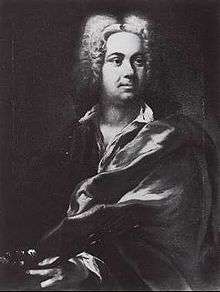Daniel Gran
| Daniel Gran | |
|---|---|
 | |
| Born |
22 May 1694 Vienna |
| Died |
16 April 1757 (aged 62) Sankt Pölten |
| Nationality | Austria |
| Education | Sebastiano Ricci (Venice, Italy) and Francesco Solimena (Naples, Italy) |
| Known for | Painting |
| Notable work | St Anna's Church's frescoes (Vienna), Österreichische Nationalbibliothek Prunksaal's frescoes |
| Movement | Baroque |


Daniel Gran (22 May 1694 in Vienna – 16 April 1757 in Sankt Pölten), was an Austrian painter. His pictures ornament several public buildings in his native city. He was of some consideration in his time and after a century of Italian dominance one of the first important painters of the German-speaking countries, but his works are relatively unknown outside of Austria and Germany today.[1]
Life and education
Gran was one of the sons of Hofkochs Kaiser Leopold I. He was sponsored by the House of Schwarzenberg, which helped finance his studies and travels in Italy, where he studied primarily with Sebastiano Ricci in Venice and Francesco Solimena in Naples. His works can be noted for a wavering between Venetian influence in coloring and Neapolitan influence in composition. In addition to the Princely House of Schwarzenberg, he also painted for the House of Habsburg; 1727 he was appointed court painter.
From 1732, he used the title "Daniel le Grand," and from 1736, with the predicate "della Torre." In the absence of documentation, the verifiability of his nobility in the Registry of Vienna Gratialarchivs is doubtful. More accurate is the master title and coat of arms of an imperial Fähnrich, Nikolaus Gran della Torre (ennobled on 12 May 1621) which successfully laid his claim and revived his title. A wrongful use of noble titles and predicates would have been unthinkable in the time and exposed the social position of the artist.[2]
Towards the end of his career, his paintings appear increasingly less "Baroque" (in figural dimensions, illusionism). Gran therefore can be seen as an important precursor of classicism.
In 1894, in Vienna's Rudolfsheim-Fünfhaus (15th District), the Grangasse street was named after him.
Works
- Frescoes
- Palais Schwarzenberg (Vienna)
- Prunksaal of the Österreichische Nationalbibliothek (formerly Hofbibliothek) (Vienna)
- Eckartsau castle
- Pilgrimage church Sonntagberg
- cathedral in Sankt Pölten
- Kaisersaal in Stift Klosterneuburg
- Neues Rathaus and Landhaussaal in Brno
- Altar paintings
- Churches in the Stift Herzogenburg and Stift Lilienfeld
- Parish Church of Hirschstetten
- Cathedral in Sankt Pölten
- St Anna's church (Vienna)
Self-portrait in the monastery of Herzogenburg.
Gallery
 St. Elizabeth Distributing Alms, 1736
St. Elizabeth Distributing Alms, 1736 Charity of St. Elizabeth of Portugal, 1736/1737
Charity of St. Elizabeth of Portugal, 1736/1737 Christ and the Roman Captain, 1736
Christ and the Roman Captain, 1736- Paradise (sketch for a ceiling fresco in Sonntagberg basilica, Austria), 1736
- Mary with Jesus and John, 1745
- Rest on the Flight to Egypt, 1746
- Glory of the House of Austria, Ceiling fresco in marble hall of Klosterneuburg Monastery (1749)
 Allegory of Four Seasons, 1757
Allegory of Four Seasons, 1757- Madonna and Child with the St. George and St. Stephen
 Glory of Virgin Mary
Glory of Virgin Mary St. Anne in St. Anne's Church, Vienna
St. Anne in St. Anne's Church, Vienna Ceiling fresco of the State Hall dome
Ceiling fresco of the State Hall dome
Notes
- ↑ Bryan, Michael (1849). Robert Edmund Graves, ed. Biographical and Critical Dictionary of Painters and Engravers. London: George Bell and Sons. p. 293.
- ↑ Walther Buchowiecki: Der Barockbau der ehemaligen Hofbibliothek in Wien, ein Werk J.B.Fischers von Erlach, S 146f. Georg Prachner Verlag, Wien 1957
References
- Knab, Eckhart (1977). Daniel Gran (in German). Herold. p. 308. ISBN 3-7008-0131-9.
Further reading
- Heinrich Kábdebo (1879), "Gran, Daniel", Allgemeine Deutsche Biographie (ADB) (in German), 9, Leipzig: Duncker & Humblot, pp. 578–579
- Eckhart Knab (1964), "Gran, Daniel Johannes", Neue Deutsche Biographie (NDB) (in German), 6, Berlin: Duncker & Humblot, pp. 739–741; (full text online)
- Eckhard Knab: Daniel Gran. Herold, Wien/München 1977, ISBN 3-7008-0131-9.
- Johann Kronbichler: GRANDEZZA - Der Barockmaler Daniel Gran 1694-1757. St. Pölten 2007, ISBN 978-3-901863-28-8.
External links
- Literature by and about Daniel Gran in the German National Library catalogue
- Daniel Gran in: Austria-Forum, the Austrian knowledge network online (at AEIOU)
- Werke von Daniel Gran in: Digitales Belvedere
| Wikimedia Commons has media related to Daniel Gran. |